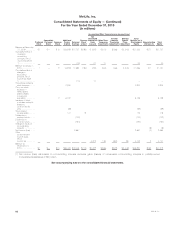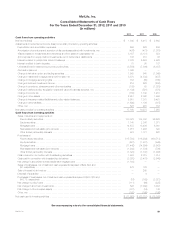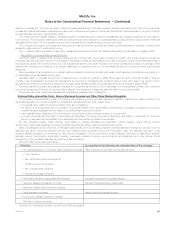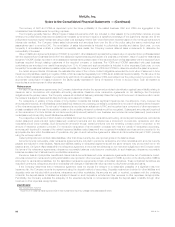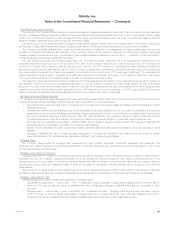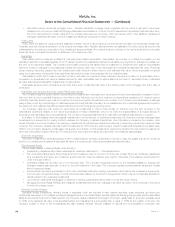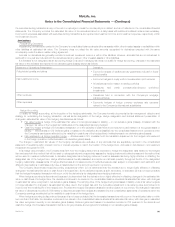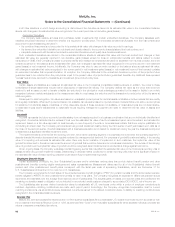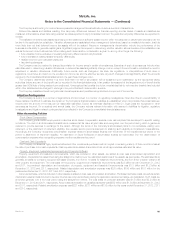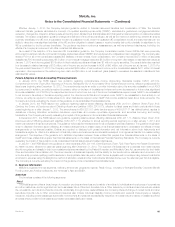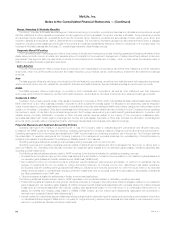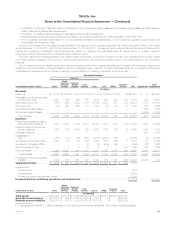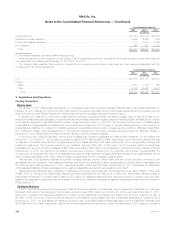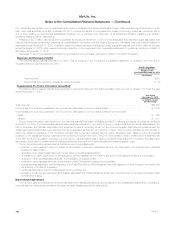MetLife 2012 Annual Report Download - page 98
Download and view the complete annual report
Please find page 98 of the 2012 MetLife annual report below. You can navigate through the pages in the report by either clicking on the pages listed below, or by using the keyword search tool below to find specific information within the annual report.
MetLife, Inc.
Notes to the Consolidated Financial Statements — (Continued)
In all other situations in which hedge accounting is discontinued, the derivative is carried at its estimated fair value in the consolidated balance
sheets, with changes in its estimated fair value recognized in the current period as net derivative gains (losses).
Embedded Derivatives
The Company sells variable annuities and purchases certain investments that contain embedded derivatives. The Company assesses each
identified embedded derivative to determine whether it is required to be bifurcated. The embedded derivative is bifurcated from the host contract and
accounted for as a freestanding derivative if:
‰the combined instrument is not accounted for in its entirety at fair value with changes in fair value recorded in earnings;
‰the terms of the embedded derivative are not clearly and closely related to the economic characteristics of the host contract; and
‰a separate instrument with the same terms as the embedded derivative would qualify as a derivative instrument.
Such embedded derivatives are carried in the consolidated balance sheets at estimated fair value with the host contract and changes in their
estimated fair value are generally reported in net derivative gains (losses) except for those in policyholder benefits and claims related to ceded
reinsurance of GMIB. If the Company is unable to properly identify and measure an embedded derivative for separation from its host contract, the entire
contract is carried on the balance sheet at estimated fair value, with changes in estimated fair value recognized in the current period in net investment
gains (losses) or net investment income. Additionally, the Company may elect to carry an entire contract on the balance sheet at estimated fair value,
with changes in estimated fair value recognized in the current period in net investment gains (losses) or net investment income if that contract contains
an embedded derivative that requires bifurcation. At inception, the Company attributes to the embedded derivative a portion of the projected future
guarantee fees to be collected from the policyholder equal to the present value of projected future guaranteed benefits. Any additional fees represent
“excess” fees and are reported in universal life and investment-type product policy fees.
Fair Value
Certain assets and liabilities are measured at estimated fair value in the Company’s consolidated balance sheets. In addition, the notes to these
consolidated financial statements include further disclosures of estimated fair values. The Company defines fair value as the price that would be
received to sell an asset or paid to transfer a liability (an exit price) in the principal or most advantageous market for the asset or liability in an orderly
transaction between market participants on the measurement date. In most cases, the exit price and the transaction (or entry) price will be the same at
initial recognition.
Subsequent to initial recognition, fair values are based on unadjusted quoted prices for identical assets or liabilities in active markets that are readily
and regularly obtainable. When such quoted prices are not available, fair values are based on quoted prices in markets that are not active, quoted prices
for similar but not identical assets or liabilities, or other observable inputs. If these inputs are not available, or observable inputs are not determinative,
unobservable inputs and/or adjustments to observable inputs requiring management judgment are used to determine the fair value of assets and
liabilities.
Goodwill
Goodwill represents the future economic benefits arising from net assets acquired in a business combination that are not individually identified and
recognized. Goodwill is calculated as the excess of cost over the estimated fair value of such net assets acquired, is not amortized, and is tested for
impairment based on a fair value approach at least annually or more frequently if events or circumstances indicate that there may be justification for
conducting an interim test. The Company performs its annual goodwill impairment testing during the third quarter of each year based upon data as of
the close of the second quarter. Goodwill associated with a business acquisition is not tested for impairment during the year the business is acquired
unless there is a significant identified impairment event.
The impairment test is performed at the reporting unit level, which is the operating segment or a business one level below the operating segment, if
discrete financial information is prepared and regularly reviewed by management at that level. For purposes of goodwill impairment testing, if the carrying
value of a reporting unit exceeds its estimated fair value, there may be an indication of impairment. In such instances, the implied fair value of the
goodwill is determined in the same manner as the amount of goodwill that would be determined in a business combination. The excess of the carrying
value of goodwill over the implied fair value of goodwill would be recognized as an impairment and recorded as a charge against net income.
On an ongoing basis, the Company evaluates potential triggering events that may affect the estimated fair value of the Company’s reporting units to
assess whether any goodwill impairment exists. Deteriorating or adverse market conditions for certain reporting units may have a significant impacton
the estimated fair value of these reporting units and could result in future impairments of goodwill.
Employee Benefit Plans
Certain subsidiaries of MetLife, Inc. (the “Subsidiaries”) sponsor and/or administer various plans that provide defined benefit pension and other
postretirement benefits covering eligible employees and sales representatives. Measurement dates used for all of the Subsidiaries’ defined benefit
pension and other postretirement benefit plans correspond with the fiscal year ends of sponsoring Subsidiaries, which are December 31 for
U.S. Subsidiaries and November 30 for most non-U.S. Subsidiaries.
The Company recognizes the funded status of the projected pension benefit obligation (“PBO”) for pension benefits and the accumulated pension
benefit obligation (“APBO”) for other postretirement benefits for each of its plans. The Company recognizes an expense for differences between actual
experience and estimates over the average future service period of participants. The actuarial gains or losses, prior service costs and credits and the
remaining net transition asset or obligation not yet included in net periodic benefit costs are charged to accumulated OCI (“AOCI”), net of income tax.
The Subsidiaries also sponsor defined contribution plans for substantially all U.S. employees under which a portion of employee contributions is
matched. Applicable matching contributions are made each payroll period. Accordingly, the Company recognizes compensation cost for current
matching contributions. As all contributions are transferred currently as earned to the defined contribution plans, no liability for matching contributions is
recognized in the consolidated balance sheets.
Income Tax
MetLife, Inc. and its includable life insurance and non-life insurance subsidiaries file a consolidated U.S. federal income tax return in accordance with
the provisions of the Internal Revenue Code of 1986, as amended (the “Code”). Non-includable subsidiaries file either separate individual corporate tax
returns or separate consolidated tax returns.
92 MetLife, Inc.


